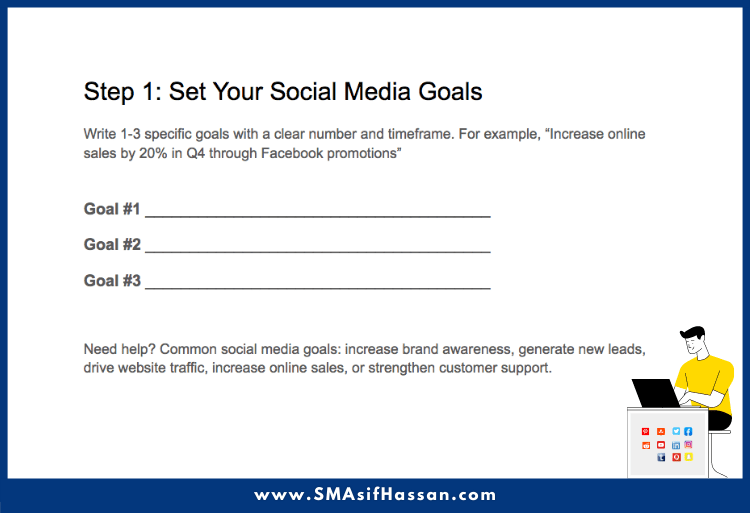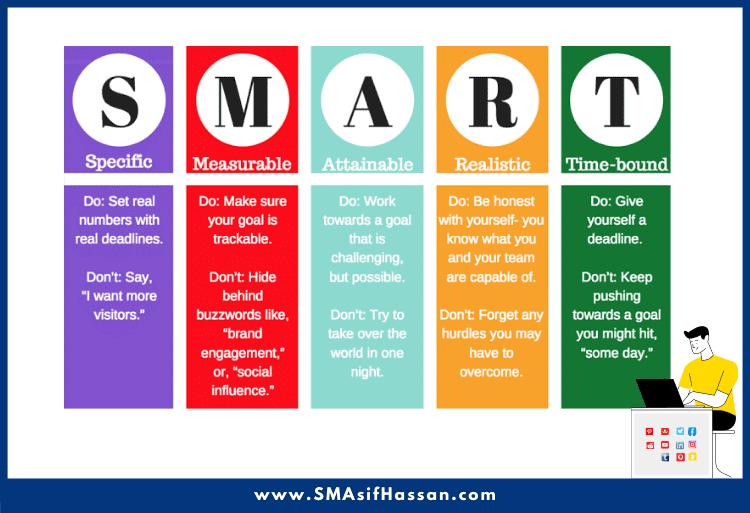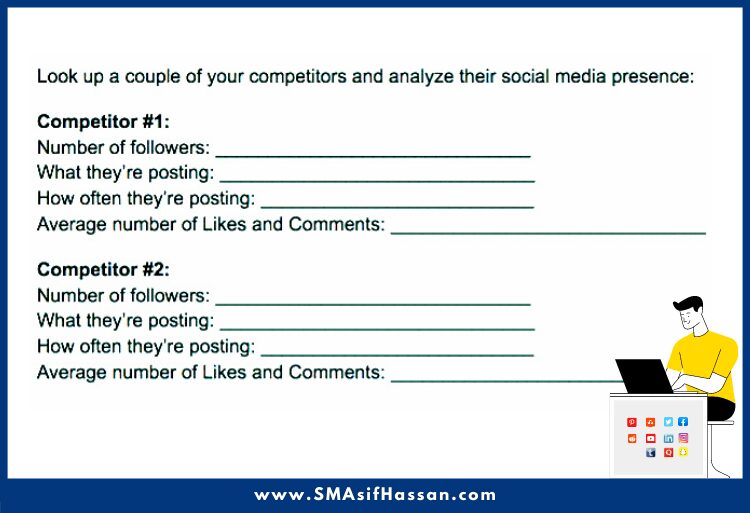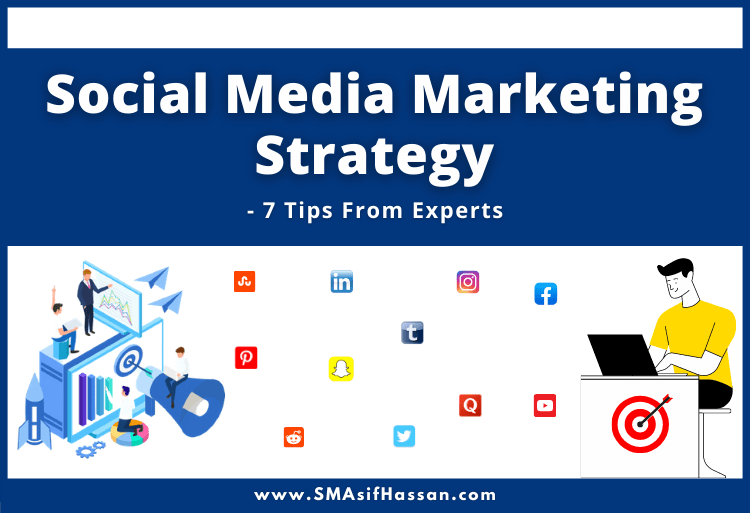In this date, like everyone else you also know your business needs a social media account. But not everyone knows how to maintain and know the way to bring the best out of this platform. Even some of them don’t know what Social Media Marketing is!!!
What do you think? Do you know enough to reap of the benefits? Scrolling through your account, you will see a lot of brands having a social media account. Notice that not every brand is known to customers. People are talking about only some of those.
What makes them different? How can you be one of those brands?
The answer is Strategy. To make a place among those prominent some, you definitely need to know the strategies. This is the one thing that helped them to grow and shine. Creating a strategy definitely needs plenty of your time and concentration, but it is not anything like biting on bullets.
Here, I have created an effective and comprehensive social media marketing strategy to get the result you are looking for. This article is going to provide you with what you need to know to succeed in the world of Social media.
Buckle Up, here is the set of strategies, outlined for you:
One of the easiest ways to make your social media marketing strategy is to ask yourself these questions :
- Why are you willing to be on social media?
- Who’s your target audience?
- Which metrics do you need to track?
- What are you willing to share?
- Where are you willing to share?
- When are you willing to share?
- How is your competition’s performance?
Important point about strategy:
You might have a strategy for each of your social media channels, such as Facebook, Twitter, Instagram or other social media marketing sites. Here I will be talking about your overall strategy. Hopefully, your overall social media marketing strategy will lead up by this.
Now, moving into the details :
-
Why are you willing to be on social media?
A common problem that most of the businesses face today is, they just swim with the tide. Just because every business nowadays has a social media account they also open one. But they never think about why they are here.
How they can use it as their marketing tool. Even there are some businesses who give the authority of their business page to the junior workers. Why? Just because, they think the juniors are more familiar with technologies.
What a waste of social media’s power! Just open an account and upload some images or contents is of no use until you know your goal.
So, before having an account on the digital platform set your goal. Know what you want from here.
Normally you can have the following nice social goals for your brand:
- Develop brand awareness – This is for the new business. you can make your band well-known by growing and engaging social media followers.
- Bring traffic to your website – If you want to increase traffic on your business website, you can share links on your social media account.
- Create new leads – To get email subscribers, event registrations and new leads.
- Increase revenue (by increasing signups or sales) – If you own an e-commerce site, Posting promotional contents or through advertisements, you can raise the sell.
- Increase brand engagement: Your social media account can engage a lot of potential customers by your contents. The more engagement your content can create, the more chances to be well-known.
- Make a community based on your business – You can build a community for your customers. Whose recommendations and reviews can boost up your sell and brand awareness.
- Give social customer service – The social media can act as a hub to interact with your customers.
- Try to listen to public opinion about your brand – To know what people are thinking about your business. How can you provide more customer satisfaction?
You can have one or more social media goals and that’s okay.
It completely depends on your business type and stage of your brand.

Note: Usually, it’s easy to focus on just one goal unless you have a whole team where the team combined with different people or groups that can try to achieve different goals. And make sure the goal fits well with your business strategy also.
Whatever your goal is make sure the goals are SMART. Here SMART stands for Specific, Measurable, Attainable, Relevant, and Time-bound.

- Specific: Your goal should be focused on and define a real outcome. Otherwise, your goal will be to Vogue to achieve.
- Measurable: Have some clear definition of success. It will help you to measure your achievement and evaluate your progress.
- Attainable: Your goal can be challenging but remember it should be achievable too. Do not make any ridiculous goal out of over-enthusiasm.
- Relevant: The goal should resonate with your brand. Ask yourself whether the goal is supporting your business objectives and values.
- Time-bound: Set a realistic time frame to achieve the goal. This will keep you motivated to complete your task regarding the goal.
Example: Our goal is to create a community of 30,000 unique customers for our brand within three months using Facebook.
These criteria will make your goal more likely to be fulfilled. Don’t set any higher goal that is unachievable. Be realistic and work smart for them.
There are plenty of businesses accounts on different social media platforms who set some fuzzy goals. Do not be like them. Select the goals wisely so that it helps your business to grow.
Another thing to remember that there are a lot of social media platforms. You do not need to stand out all of them. Find where you are most likely to connect with your target market. And play the marketing game there.
-
Who’s your target audience?
Once you have figured out why you want to be on social media, the next thing is to figure out who’s your target audience.
Not all the followers are good for you. You might have a lot of followers on your social media account but if they are not interested in your product, no use of them.
For instance, suppose you are a makeup brand. Here you have nothing to do with football fans. Or you are selling stairlifts for home-owners, here a group of young people who live rental or with parents is of no use.
The same rule applies to the geographical area. If you are selling something that you can not ship to other areas, then you should not want any followers from those places.
So rather trying to grow a lot of random followers, focus on increasing the potential followers. Who can be your customers?
By knowing and understanding your target audiences opinion will assist you more to answer some questions. About what, where, and when you are going to share your content more easily.
Suppose, if a travel and lifestyle brand understands that its target audience loves to read about new & interesting places and travel tips, it can provide such content on its social media pages.
Booking.com is a travel agency that lodge reservations. They let know the Travelers about new places.

Another important thing, you should consider where you are most likely to find your users.
If your target market is middle-aged people around the age between 25 and 45, you will find them on Facebook.
But if you are targeting the young generation they are most likely to found on Instagram or Snapchat. A good practice to try here is to produce marketing personas.
There are different ways of making marketing personas. Let’s discuss it.
- Who they are? (E.g. job title, gender, salary, location, age etc.)
- What can you provide that they will feel interested? (E.g. educational content, information on new products, case studies, entertainment etc.)
- Where do they normally spend their time online? (E.g. Facebook, Instagram etc.)
- When do they want to find the type of content that you can provide? (E.g. weekends, during their festivals, etc.)
- Why they are interested in the content? (E.g. to get better at their job, to stay up to date with something, to become healthy etc.)
- How can they consume the content? (E.g. read social media posts, watch videos, and other etc.)
Find the answers and work according to that. That is how you can bring out the potential customers from your followers.
So, understanding your target audience’s demographic and psychographics is crucial. It will help you to decide the platform you will use, and the best way to reach your goal.
You don’t need to start from the beginning. If you’re running your business for a while, you may already have good knowledge of your target audience. If you write it down so that you can share it with the team or use for your future reference then it can be helpful for you.
Key Take away:
- Decide who are your audiences
- Understand them
- Find the right social media networks to reach
- Do not waste time on social media platforms where you will not find your audiences.
Are you thinking about where to find an audience?
Obviously, you do not know every profile on social media as well as who can be interested in your products. And organically you can not reach to all of them. So how will you make an appearance in front of all the potential customers?
For this, you should consider paid social media advertising. This will allow you to target your ads demographically.
This type of advertising enables small or new brands to reach users who aren’t following the pages directly but have shown interest in a product or service in the past, that you’re offering.
This is an excellent way to increase your brand awareness with a relatively small amount. You can also customize your plan as which age group or which gender should find which ads. That means it allows you to identify your audience based on different criteria.
Plan your marketing budget for the social networking site and spend according to that to reach more customers. This is cheaper in cost but great in effect.
-
What are the Metrics to track?
The social media account of your brand should be data-driven. That means you have to focus on social media metrics.
Here are the Metrics, you should keep your eyes on:
Reach :
Reach means how many unique users saw your post? Are your posts spreading? Tracking reach is possibly the most important task where the algorithms are constantly changing.
Clicks :
How many times your content, or brand name is getting clicked. This allows you to understand if users are moving through the marketing funnel. The clicks represent how many people are curious about your content. And if the post is encouraging the users to be you, customers.
Engagement:
Once your post is clicked than how many of the users have actually reacted on it is engagement. You can see if the ratio of reach and impression is good enough. This gives you an insight into audiences willingness to interact with you.
Hashtag performance:
What and which hashtags were most used and most associated with your brand? Or which hashtags have created the most engagement? The answer to these questions can help you to shape your focus on types of content.
Organic and paid likes :
Organic likes or reactions shed light on whether people are interested in your brand. On Facebook organic engagement is quite harder to gain attraction. That is why a lot of brands opt for Facebook Ads. But getting organic likes are pretty easy on Instagram. These differences allow you to shape your time and money investment decisions on.
Sentiment :
This completely depends on how audiences are taking your contents. You can measure it by like, reacts or comments on your contents. What are peoples sentiment towards your brand and how they can associate with it? It is always wise to look for users thoughts.
Which metrics on which site you are going to check depends on your business goals. And most of the time, you will have to track different metrics on different platforms.
For example: If your goal is to increase brand awareness, you will check the follows, and shares. For higher engagement, you have to check like, comments or mentions.
It completely depends on your goal.
-
What are you willing to share?
Let me tell you some facts. It is crucial for your brand to share images or videos. Probability of audiences to share visual contents is 40 times higher than other contents on social media. This is what made Instagram popular in recent years.
According to the top brands of Instagram ‘ There is 4.21% per follower engagement rate’. And it is higher by 58 times and 120 times respectively on Facebook and Twitter. Most important of all is ‘ 64% of customers reported that they like to watch a video before buying a product or Service ‘.
Now you are thinking about what type of content you need to share. Say, for example, you have a plan to share videos or images.
But let’s pause for a second!
Before planning any content, remember social media was never meant to be a marketplace. If you are going to advertise constantly, it will irritate your audience. So keep it social and sprinkle some promotional material.
Based on your audience psychology create contents with a mixture of entertainment, information and promotion. You can follow the Influencers here. The way they create contents which are interesting to their customers. Do the same for your brand.
If you are still confused about how to create and select contents for your brand, follow these rules.
The 80-20 rule:
- 80% – posts for entertaining, informing, or educating your customers
- 20% – posts for promoting your product or service
The Rule of One-Thirds:
- One-third to convert your readers, promote your business hence generate profit.
- Share stories and thoughts of leaders of your industries.
- Interact with your customers directly.
Now, let’s get introduced to the theme.
As we’re discussing your social media marketing strategy here so let’s think on a higher level. Instead of the types of content to share, Let’s use the word “theme” instead of the type of content.
Here are some brands with their theme(s):
- MeUndies, it’s an underwear brand which shares images from their customers and images of their products on their Instagram profile.
- Huckberry, it’s an outdoor and adventure brand which shares their editorial content and high-quality images of the outdoors on their Facebook profile.
- Burrow, it’s a luxury couch brand which mainly shares memes on their Instagram profile.
Here is a post from Burrow, this involves the audiences

Here is a post from Burrow, this involves the audiences emotionally and connects them more towards the brand.
If you go inside their social media profiles that I mentioned above, you can easily notice that the brands have many main themes instead of one. If you have a lot of themes, your audience will easily be engaged without any confusion.
Friendly Help: If you are a new bee in social media marketing, you might get confused with what to share? What will be the contents of? Do not worry! I got your back with a 7 days content ideas.
what you will post depends on your goals. There are a lot of things that hold importance for your marketing plan. But keep yourself focused on what you need the most.
As every business is unique, this plan will just give you an idea. Customize it according to your brand.
Sample 7 days Content Plan
1. Monday (Master The Week)
This is the day to set up your week right. Plan for at least 5-7 posts on social networks. Try your best to appear on all the social media sites (i.e., Facebook, Instagram, Twitter, etc.) On this day share some inspirational quotes.
Or you can post a blog on how you have started the journey. Share your passion or vision. People get attached quickly with personal stories. And do not forget to go leave some comments on influencers pages. It helps to get attention.
2. Tuesday (Time for Engagements)
Give your time to your customers or followers. Reply to their comments. Check inbox and DMs. And then post a question to the community to spark the engagement. Let the people talk about you or your brand.
Ask what they liked about your story? Or what kind of hurdles they face with the type of your product or service? And follow about 10 new Twitter / Facebook/ Instagram accounts. And like or react on some posts.
3.Wednesday (Work for Promotion)
It is time for promotion. Announce a special offer or giveaways or sale. You can send e-mail to the potential customers about your promotion. And make sure to post a captivating poster about the promotion announcement on all the social accounts.
4. Thursday (Tour for you and the audience)
You can post some behind the scenes of your work. Or any sneak pic of upcoming products. Make the audience feel curious, and ask them what they think you are coming with.
Leave some thoughtful comments on other pages related to your business. If you are a footwear brand you can comment on travel or hiking related pages.
5. Friday (Find the numbers)
Track your analytics and reviews. Which posts are more engaging. Boost a blog on your Facebook to new viewers to increase brand awareness.
6.Saturday (Share customers experience)
If you already had sales, share the reviews from your customers. If not, then create a post reminding the audiences about your promotional offers. Hit all your social media accounts, and check on your competitors.
7.Sunday (Make it a Fun day)
Share some thoughts of leaders of your industries. Or any viral video related to your product or the users. You can post some life hacks or expert tips videos.
This is a framework for you. Adjust your plan the way it fits your business.
-
Where are you willing to share?
The next step is to find out where you want to share your content. In other words, which social media platforms do you prefer for your brand?
Before moving forward, remember that your brand doesn’t have to be on every social media platforms. Just on the important ones.
Again, the understanding of your target audience will come in handy for you here. In which platforms are your target audience mostly remain active? Why they are interested in that platform?
For example, teenagers and young adults might like entering into Instagram when they become bored to watch what their friends might be doing.
Another thing to consider is, what is the ’s “X factor” of your brand? Are you good in photography, videos, or writing?
Which type of content can represent your business the best? Depending on that also you can select the platform because Specific platforms are well to specific content types.
For example, photos can be found on Instagram, long-form videos can be found on YouTube. Although things are changing these days. Yet it is best to post the content where it suited best.
Suppose, It is a mobile brand. If you want to show some of the special features with a short video, Instagram and Facebook are great for that.
But if you are willing to post an in details video than you definitely have to choose YouTube. Most of the people will search for reviews or detailed feature here.
Besides, people are less likely to watch longer videos on Instagram, Facebook or in Pinterest.
Here is a list of types of content and where the suit best:
- Written post, blogs, Articles: If they are more than 1500 words, LinkedIn and Facebook are perfect.
- Images: Instagram and Pinterest are the best options. Facebook, Snapchat, Twitter can also be considered.
- Videos: YouTube is the king in this section. But for a shorter length video, Instagram is the best.
- Video Stories: Facebook, Instagram and Snapchat are popular for these.
- Live Videos: Facebook is the best platform for live stream videos.
-
When are you willing to share?
Once you confirm with your content type and posting platform, now you have to figure out when you want to share your content. Yes, Time is an important factor here.
Stay still and take a breath.
Let us take a step backwards and see this from a superior level again. Consider the behaviours of your target audience before deciding which time of the day or days of the week you want to post about your content.
When do they normally on social media to search the type of content that you’ll share?
Here are some examples of it:
- Sports fans mainly visit social media just before, during and just after the end of sports events to find and learn the content about the event.
- Athletes may be on Instagram while they are taking rest after their morning or evening workouts.
- People who like to travel may be more and more active on social media in the weekends when they are trying to plan for their next trip (or after the end of their work. they may be dreaming about their next trip).
- Mothers of babies may be visiting social media when they are breastfeeding their babies in the midnight.
So, after the discussion that is elaborated above, you might understand that there is no universal best time to post. It depends mainly on your audience. So, for this, focus on the usual behaviour patterns that your target audience are having.
When you have created your social media marketing strategy, you can then find your brand’s perfect time to post through experimentation.
You can manually post all your contents after finding out the right time. To be honest, this is not the best way. To be more efficient, create your social media content calendar.
Here list the date and time when you will share the contents. It will ensure that your posts are spaced out appropriately and also published at an optimal time.
Do not forget your missions while creating the calendar. That will ensure that your posts are supporting your business and helping you to reach your goal.
Note: Use a scheduling tool to prepare the messages in advance. Composing just before posting often decreases the quality of the content.
Suggested Scheduling tool: This tools will boost your workflow. Use whichever you find better for you.
You can also use Social media automation tool if you can not stick to mobile or laptop all the time. These are sort of software or tools to perform specific tasks on social media sites without any human intervention.
Simply, a programme will automate things like posting and sharing content on Facebook, Instagram, Twitter, and other platforms for you.
Suggested Automation Tools for you:
-
How is your competition’s performance?
The last part of your strategy is observing your competitors activities and performances.

If your competitors are using social media, you have an opportunity to check them out. You can learn about their activity, and also absorb some tactics, if necessary.
Not every brand from the same industry is your competitor. So, analyse who really are your competitions.
Observe what are they doing and how well that is resulting. This will give you a good sense of expectations and spot opportunities from your industry. As well as you will be able to set accurate social media target for your brand.
For instance, suppose one of your competitors is dominating on Facebook but has little appearance and popularity on Instagram or Twitter. Rather, trying to snatch audiences of Facebook, you should concentrate on the platforms where users are undeserved.
You should put your efforts on the networks where your competitor is less dominant. This effort can make you the dominant player on other networks.
Another important thing is to listen to what users are talking about your competition. This means social media listening about your competition.
Find out the company name, their tactics and relevant keywords. Which contents of them are getting shared and creating more engagements. And what are users view and thought about them? To spy on your competitors and find out which contents are successful you can use Buzzsumo
These are going to help you to sort out your plan or update the existing ones.
But make sure, not to get so involved on their social media account that you have no time left for your one. Or you completely make an u turn from your goal.
Now that you got a clear idea about the strategies. It is time to check if they are bringing any positive results. Or to what extent the strategies are working for you.
No matter how much your social effort is, getting a 100% result effective result is not always possible. So, make a schedule check to find if you need to make any changes. Without analyzing the result you will not be able to arrive in a decision.
There are a lot of analytical tools to check these. But initially, you can use the insights. These are provided by the social media platforms it selves. Such as Facebook has its insight as an analytical tool. Twitter and YouTube have an analytics section.
Make sure to observe these sections to find if you are achieving your success. Which kind of contents are getting more popular, and bringing more traffic.
Use these tools to see if you are achieving your success. If your content is getting popularity, then create more like that. But if not then find out why it’s not working.
Be confident to make changes in content types. Remember your followers are the kings here. You should create content according to their expectations. You can also ask comment from the followers. How they feel about your brand if there is any suggestion to improve. You may get some brilliant ideas from the customers too.
Question may arise how to schedule your audit? So here is a checklist you can follow:
Checklist Framework :
How often you should check various analytics? Or how your checklist should look like?
Here I am presenting a checklist for you.
I am breaking this down in 4 parts, depending on the time gap:
- Daily
- Weekly
- Monthly
- Quarterly
Everyday
- Check your calendar and update if required
- Reply to the comments of your customers or followers.
- Check out the trending hashtags.
- Monitor the hot topics or the latest news related to your business.
- Find out what your competitors are posting
- Monitor and comment on the Influencers posts.
- Follow some new accounts.
Things you should check weekly are:
- Create a new posting schedule for the week.
- Track the result of your campaign or promotional posts.
- Check which posts of your competitors are performing well.
- Engage with some partners or brands.
On a monthly basis:
- Mark your previous month’s success and integrate them on your strategy.
- Check out the overall performance of your competition.
- Compare your and your competitor’s overall performance and check which sections you are mastering and in which sections you need to improve.
- Experiment with new campaigns.
- Research upcoming events or news that have impacts on your business or can promote your brand.
And finally, after every quarter :
- Review and estimate your KPI from last quarter. And see where you stand.
- Analyse your target audience and find out if they are they are the right people.
- Make sure to be consistent on all the social media sites.
- Plan your goals for the next quarter
If you are a beginner, try to follow this checklist as much as possible. This will help you to not only with expanding your business, but also to keep track of your activity.
Bonus Tips for you!
I have already talked about the bigger approaches for a balanced and effective social media marketing strategy. Now I will give you some tips which will make your work much easier and will save you time.
Look of your profile MATTERS:
As a brand, on social media, you want to find potential customers. Simply like that the customers also look for reliable product or service provider. So, make yourself trustworthy.
People will check your bios and profiles to find out if you are reliable.
Take time to create your profile accurately and fill in your bio. Ensure creating landing pages on your brand’s website for the visitors who will click through from the social media accounts.
The followers or customers have to see the products or your showroom virtually. So, your visual look becomes vital. Try to use the user-friendly colour schemes, and keep your logos and other graphics aligned.
After setting up your page, ask yourself if the page is interesting to yourself. As a customer what do you look for? Provide all those to create a better social media account.
Need Designing Help?
You may already know that each of the social media sites has different preset sizes of images. An image for Facebook’s post and story are different sized. That means every time to create an image post you have to make a different sized picture.
If you are new on a digital platform, maintaining all the other things with creating multi-sized images or posters are is a bit hard for you.
So, as an instant solution use Canva app.
Canva is a mostly free designing tool.
It has a feature that contains different sizes and templates for social media posts, postcards, posters, cards, flyers and so on. As Canva has a pre-set option, it can help you to save time to make specific dimensions for your work. All you have to do is to click on the type of content you want to develop. Then just change the images and texts as your requirement.
And the most amazing fact is, you do not need to save the designs on any USB or you are not bound to do the work from one device.
With your e-mail, you can log into your Canva account and do the work from any device you want. And designs will remain saved in the app. You can use or change them later if you need.
What if, you are not a good writer or do not have much time to write!
You may have heard that Content is the king. But it is not necessary that all other people of business or marketing be a Good Writer. So, what will you do, if you are not confident enough with your content?
PLR is the best help out there for you.
PLR Stands for Private Label Rights. Here you will find a lot of contents on various topics written by professionals. You will not have to spend hours on researching, brainstorming and then writing.
Most importantly they are affordable. And you will find a wide range here. From Family to Holidays, Home to Travel, Legal pages, Marketing, Health and whatnot.
After receiving the articles you can edit them as your wish and use any way you want. All the great articles will become yours and you will not have to waste time writing them.
When you are not online!
Maintaining a business, doing marketing online and offline, as well as carrying on your personal life! Sounds hectic, right? When are not available online, your customers can send texts. If they do not get a reply within the expected period of time, you may lose the customers. Because of low levels of user experience. In this kind of cases, Chatbots are of great help.
These are some digital tool that communicates with your customers when you are not online. You are busy with other chores, yet your customers are receiving replies from your page. How great is that!
Their activity is not confined in only sending some prepared answers. Your customers can even place an order in your absence or can resolve any problems.
Chatbots can reply to the visitor’s questions
Can take orders from Facebook even without your presence
Can give reply of comments
Able to integrate with most of the major payment systems
You do not need to know any coding language.
Conclusion:
Creating a social media account without proper strategy is like carrying water to the sea. Your account will just increase the number of total brands present on the digital platform. So before creating an account, set your strategy. And work accordingly.
If you have gone through this article, by this time you know quite a lot.
Apply this to maximize the benefit of having an account. These are the easiest way to set an effective strategy. Otherwise, you are just adding burden without gaining any benefit. However, if you feel like there are a lot, start with the easier ones. And when you think that you are prepared enough move on to the next steps.
If you want to expand your business, having a strategy is essential. Just follow these easy steps accurately and see your brand shining on the social media’s sky.
Read More:


